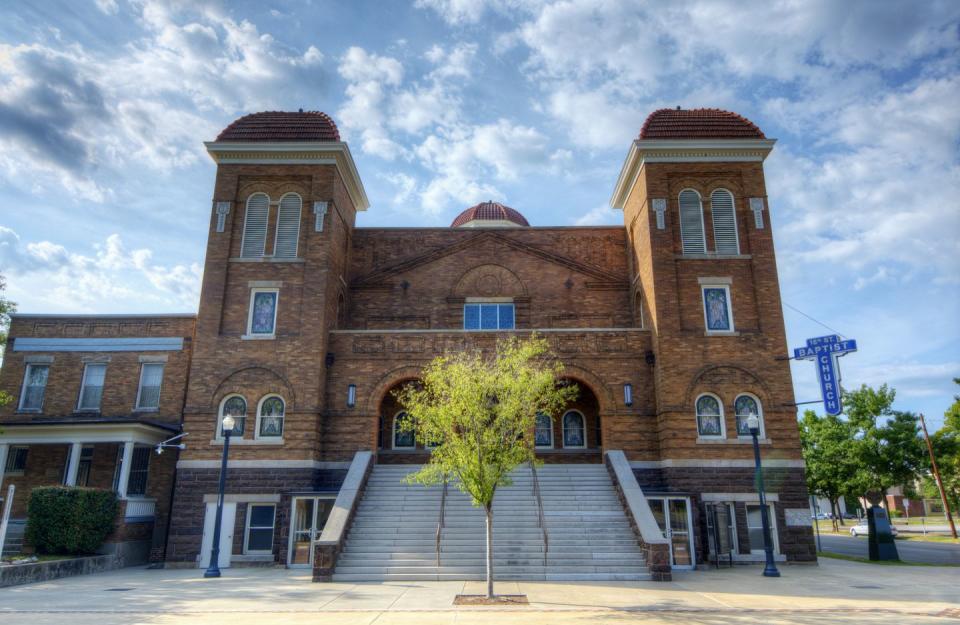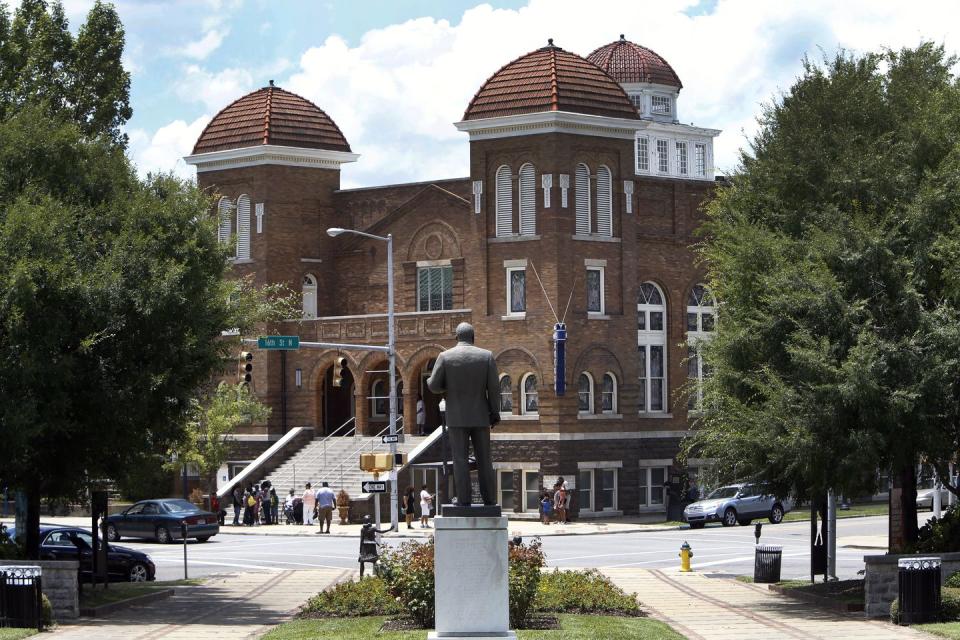How I Learned I Was a Preservationist: The Story of the Man Who Is Saving Birmingham's Sixteenth Street Baptist Church

- Oops!Something went wrong.Please try again later.
On September 15, 1963, Ted Debro was attending Martin Luther King Jr.’s church, Ebenezer Baptist, in Atlanta when the news came. Just before Reverend King started preaching his sermon, he learned that a bomb had exploded at Sixteenth Street Baptist in Birmingham, Alabama. “He came back and was speechless, just stunned,” Debro recalls. “I had seen him a number of times, but to see him speechless was something I had never witnessed before, because he always had the right words to say.”
Moments later, King was told that four girls were killed in the bombing. His reaction in that moment is seared in Debro’s memory forever: “He screamed and hollered to God, asking him if this is why he had brought him this far, to witness the death of the little girls,” Debro says.
Debro would later realize that he knew one of the four girls who had died—Denise McNair and her family had lived just a block from Debro’s family’s home in segregated Tupelo, Mississippi, and her mom was close with his sister. Debro still has a photo of their families posing together on his family’s front lawn.
These history-making moments are ones Debro will never forget, and he’s been fighting for the world to not forget them either. In fact, this very mission has been his life’s work.

On his way to and from Morehouse College in Atlanta and Tupelo in the early 1960s, Debro and his future bride would pass through Birmingham, but they made sure never to get off the bus when it stopped there. He recalls the dark cloud they’d ride through from the steel mills and the stench that went with it. “I would always say Birmingham is one place I never want to live because it was a horrible time,” he says.
That changed in the late 1970s, when Debro moved to Birmingham to take a job at Miles College. By then, Birmingham had changed, too. A few years later, Sixteenth Street Baptist Church was welcoming a new pastor—Reverend Christopher Hamlin, also a Morehouse graduate–so Debro came to the church one Sunday to welcome him to town. “The friendliness of the people and the acceptance of my family by the membership had me coming on back,” he notes. His family eventually became members of the historic church.
Debro has called the church home for more than 30 years, and he can rattle off the details of every renovation project, starting with cosmetic work in the years leading up to the Birmingham Civil Rights Institute opening in 1992. The foundation of the church was completely reworked, and the stained glass windows and skylight were repaired and restored.

Most recently, the basement was refurbished to better tell the story of the church for visitors emphasizing “the love that forgives,” the Sunday school lesson planned for the morning the church was bombed. The parsonage was also recently restored and repurposed as a museum honoring Wallace Rayfield, the architect of the church and one of the first Black architects in the country, as well as two other Black builders in the community.
“It’s history. It’s a jewel,” Debro says of the building. “It’s something that has been given to us. Think of the sacrifices that the generation from slavery provided for us for the generations to come. We certainly need to keep it restored and maintain it the best we can.”
All of these projects come with a high price tag, for which Debro has worked tirelessly to fundraise and manage as chairman of the church’s board of trustees. After his career in higher education working with grant writing, the federal government, and foundations, this is a challenge for which he is well prepared.
Through much of this work, Debro didn’t know the term ‘preservationist,’ per se. In 2015, however, Debro found himself in a training session with Brent Leggs, senior vice president at the National Trust for Historic Preservation and executive director of the African American Cultural Heritage Action Fund, as a part of their work making Birmingham landmarks that played a central role in the modern Civil Rights Movement a national monument. During their time together, Leggs saw that “Ted’s potential as a preservation leader was more than the value that he was bringing to Sixteenth Street Baptist Church and that he had the potential to support the broader preservation of Civil Rights churches in Alabama.”
Under Leggs’s mentorship, Debro has grown to understand the more technical side of preservation by using historical structures reports to restore a building while retaining its architectural integrity. Last year, he was a guest speaker for Leggs’s advanced studio course for a graduate program in historic preservation at the University of Pennsylvania. Leggs says Debro used a highly sophisticated visual tool to provide an overview of the church history at the site, a chronology of change over time and earlier renovations, and the current approaches necessary to accurately restore the historic assets. Additionally, Debro showed “how they are modifying some of the older interventions to create a more historically accurate and authentic church building and space,” says Leggs.
Leggs has also advised Debro to establish an endowment for the church to support project management and maintenance in the future, and on January 16 of this year, the National Trust's Preserving Black Churches project awarded the church a $200,000 grant as seed investment for that endowment, with plans to support Debro and the church in fundraising an additional $1.8 million.
Today, Leggs says that Debro is not only “an accomplished fundraiser, but he has [also] become an ambassador for the Black preservation movement—specifically in Alabama.” Leggs continues, “He has an incredible, respected voice, and he has learned how to use that in a really compelling way,” noting that “he’s also a kind and intellectual man…and very generous in his time and in his passion for this work.”
He's also a humble man, far more eager to speak of the importance of stewarding his church’s part of American history than his own role in it. Historically, Sixteenth Street Baptist Church was more than just a house of worship, Debro is quick to explain. With seating for around 1,200 people, its sanctuary hosted concerts and lectures for years before it began to host meetings for the Civil Rights Movement. “Rayfield designed it in such a way that it really could be the auditorium for Blacks,” Debro says. “It was known as everybody’s church.”
Before the Rayfield building, which was built in 1911, the original 1884 Gothic revival church structure was condemned by the city in 1909. A mysterious fire started around the pulpit in the Rayfield building in 1923. A split in the church congregation came in the 1970s when a pastor was accused of indiscretion. And of course there was the 1963 bombing—an event that revealed just how thick the church’s walls were.
“There are a lot of incidents that could have destroyed this church, but we say that there is power in this place, power in this location, power in this facility, power in the strength of this building,” Debro says. “It has to be our mission to keep it here and keep it strong and keep it secure.”
Debro sees a higher calling for preserving the church and parsonage, and explains that people can almost feel what happened there by touching the church walls. “It’s something you can see, you can touch, you can feel, you can experience—that’s the importance of preservation,” he says. “You preserve the old in order to move people forward with the new. It certainly would have been cheaper to build new, but you could never get the sense and feel that you get in this building when you experience it.”

Today that’s the experience thousands of school children and adults receive every week when they tour the church and hear about the tragic bombing within its walls, often from the firsthand accounts of tour guides who were in the Children’s Crusade of 1963.
“It has been marvelous, I say ‘God work,’” Debro says. “When I think back to the days in Mississippi, the days of traveling through Birmingham, the days in Atlanta, the connection with Martin Luther King himself… I really didn’t know that this is what I would be doing in my latter years. But I think I was being prepared for it.”
If you'd like to learn more about the Sixteenth Street Baptist Church or help preserve it, you can read about the church's history, schedule a tour, or donate here. You can also visit the National Trust for Historic Preservation's website to learn more about its Preserving Black Churches project or donate.
You Might Also Like

